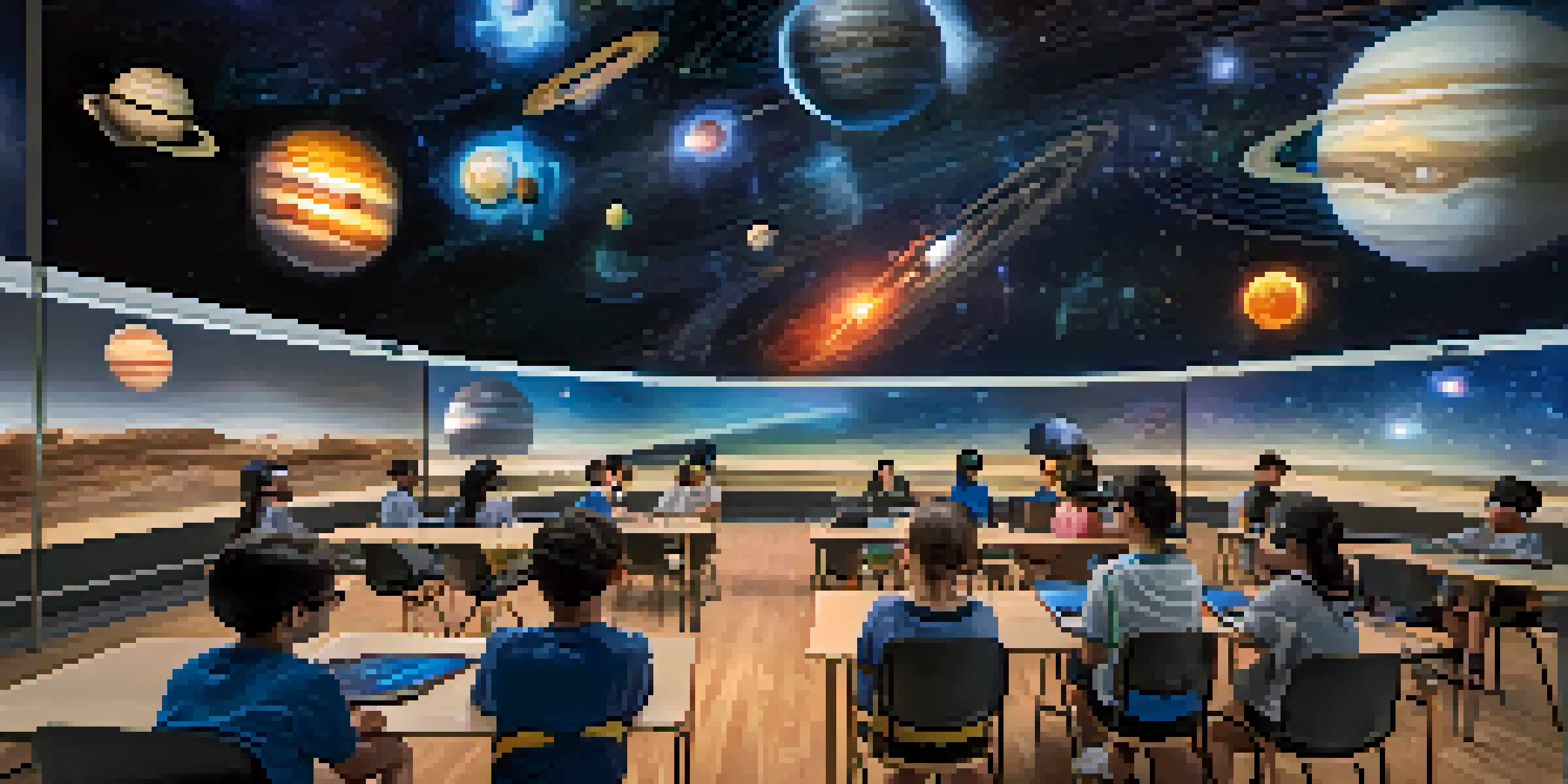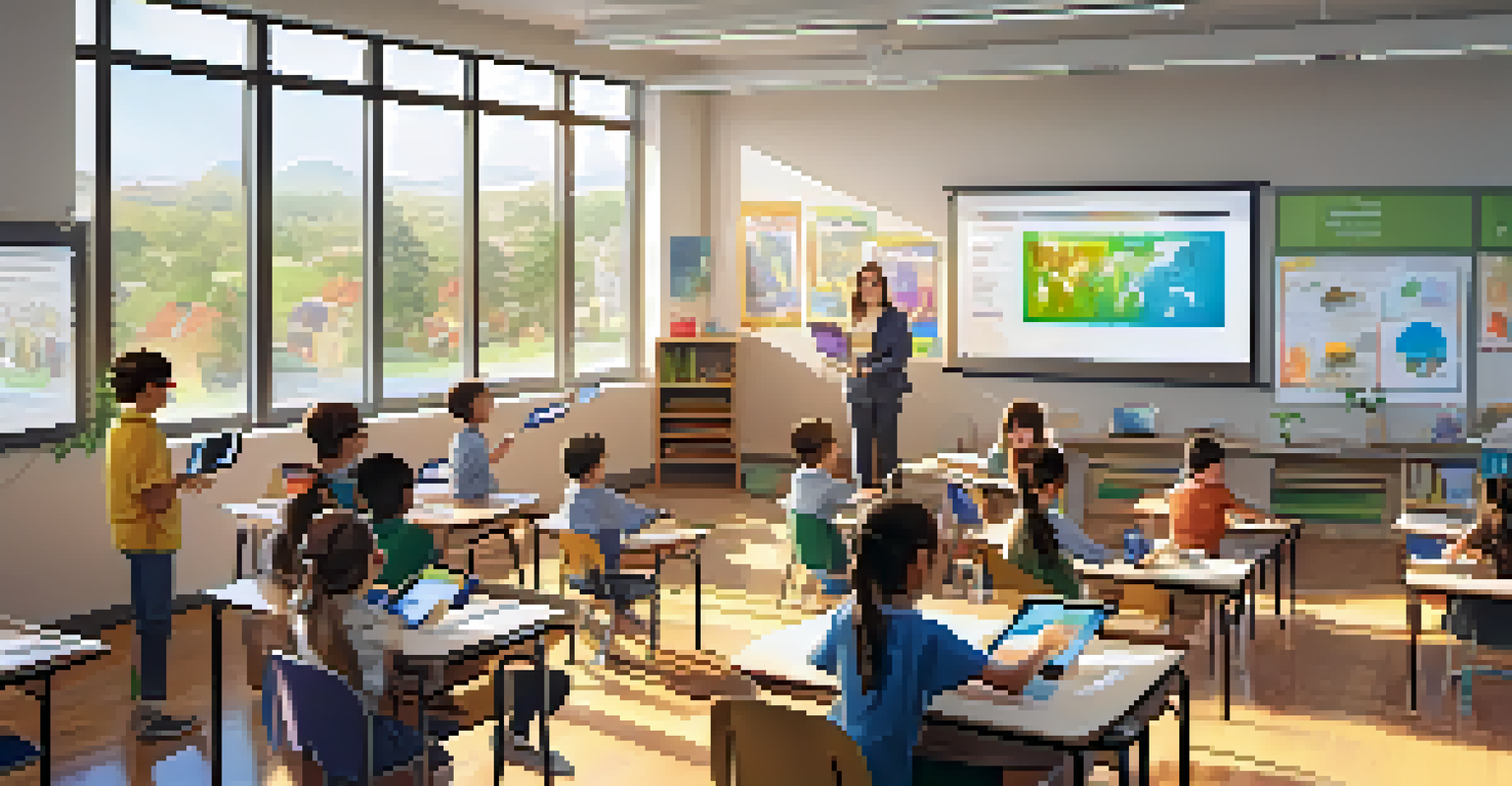Emerging Technologies: Shaping the Future of Education

The Role of Artificial Intelligence in Education
Artificial Intelligence (AI) is rapidly transforming the educational landscape. By personalizing learning experiences, AI can cater to individual student needs and learning styles. For instance, intelligent tutoring systems can adapt real-time feedback, ensuring students grasp concepts at their own pace.
The great thing about technology is that it allows us to build bridges, not walls.
Moreover, AI can automate administrative tasks, allowing educators to focus more on teaching. This means grading, scheduling, and even attendance tracking can be streamlined through AI tools. Imagine a classroom where teachers spend less time on paperwork and more time engaging with their students!
As AI continues to evolve, its potential to enhance educational outcomes grows. From predictive analytics that identify students at risk of falling behind to chatbots providing support, the future of education looks increasingly personalized and efficient.
Virtual Reality: Creating Immersive Learning Experiences
Virtual Reality (VR) offers students a chance to step into their subjects in a way textbooks never could. Picture a biology class where students can explore the human body in 3D, or a history lesson that transports them to ancient Rome. These immersive experiences can enhance understanding and retention of information.

Additionally, VR can facilitate experiences that are otherwise impossible due to geographical or financial constraints. Students can 'visit' far-off places or experience complex simulations, such as space travel or underwater exploration, all from the comfort of their classroom.
AI Personalizes Learning Experiences
Artificial Intelligence tailors educational content to meet individual student needs, enhancing engagement and understanding.
As VR technology becomes more accessible, its integration into education will likely expand. This evolution not only excites students but also prepares them for a future where digital literacy is paramount.
Augmented Reality: Enhancing Learning with Digital Layers
Augmented Reality (AR) enhances the real world by adding digital information to our surroundings. Imagine using a tablet to see historical events unfold in your classroom or viewing 3D models of molecules while studying chemistry. This blend of digital and physical worlds can create engaging learning experiences.
Education is the most powerful weapon which you can use to change the world.
AR applications can encourage interactive learning, inviting students to explore their environment with a new perspective. By simply pointing a device at an object, they can access a wealth of information, making learning more dynamic and engaging.
As educators explore AR's potential, its ability to foster curiosity and exploration in students will be key. This technology not only captivates attention but also deepens understanding by providing context and interactivity.
Gamification: Making Learning Fun and Engaging
Gamification in education is about applying game-design elements to the learning process. By incorporating points, levels, and challenges, educators can motivate students to engage more deeply with their subjects. Think of it as leveling up in a video game – each achievement can encourage a sense of accomplishment.
This method taps into students' natural competitive spirit and desire for achievement. For example, platforms like Kahoot! turn quizzes into interactive games, making review sessions lively and collaborative. When learning feels like a game, students are more likely to participate and retain information.
VR Creates Immersive Learning
Virtual Reality enables students to engage with subjects in a 3D environment, making learning more interactive and memorable.
As more educators adopt gamification strategies, the classroom experience is likely to shift towards a more playful and engaging model. This not only boosts motivation but also fosters a sense of community among learners.
The Impact of Online Learning Platforms
Online learning platforms have revolutionized access to education, breaking down geographical and financial barriers. Students can now connect with top educators and resources from around the world, all from their devices. This democratization of knowledge allows for a more inclusive learning environment.
Platforms like Coursera and Khan Academy provide a wealth of courses covering various subjects, empowering learners to pursue their interests at their own pace. This flexibility can be particularly beneficial for adult learners or those balancing education with work or family commitments.
As online learning continues to evolve, its ability to complement traditional education will enhance the learning experience. The blend of online and in-person learning could become the norm, offering students diverse ways to engage with content.
Blockchain Technology: Securing Educational Credentials
Blockchain technology, best known for powering cryptocurrencies, has potential applications in education, particularly in credentialing. By securely storing educational records on a decentralized ledger, students can easily share verified credentials with employers or institutions. This transparency can help combat fraud and streamline hiring processes.
Imagine a world where a potential employer can instantly verify your degree or certifications without the hassle of contacting multiple institutions. This not only saves time but also builds trust in the hiring process.
Online Platforms Democratize Education
Online learning platforms break down barriers to education, allowing access to diverse resources and courses for all learners.
As more educational institutions explore blockchain, its role in enhancing the credibility of qualifications will become increasingly significant. This technology promises to reshape how we view and validate educational achievements.
The Future of 5G in Education: A Game Changer
The rollout of 5G technology is set to transform education by providing high-speed internet connectivity. This increased bandwidth will enable seamless access to online resources, virtual classrooms, and collaborative tools. Students in remote areas will find it easier to connect with peers and educators, leveling the playing field.
With 5G, technologies like AR and VR can operate more effectively, offering richer experiences without lag. Imagine students participating in live virtual field trips with real-time interactions, making learning more immersive and engaging.

As 5G becomes widely available, its implications for education will be profound. Enhanced connectivity will not only facilitate access to information but also foster innovative teaching methods and learning experiences.
Preparing Educators for Technological Integration
While emerging technologies offer exciting possibilities, preparing educators to integrate these tools is essential. Professional development programs must focus on equipping teachers with the skills to effectively use technology in their classrooms. This support ensures that the benefits of innovation are fully realized.
For instance, training sessions can help educators understand how to implement AI-based tools or utilize VR for immersive lessons. By fostering a culture of continuous learning, schools can empower teachers to embrace these changes confidently.
Ultimately, the success of technology in education hinges on the readiness of educators. As they adapt and innovate, students will benefit from enriched learning environments that harness the power of emerging technologies.